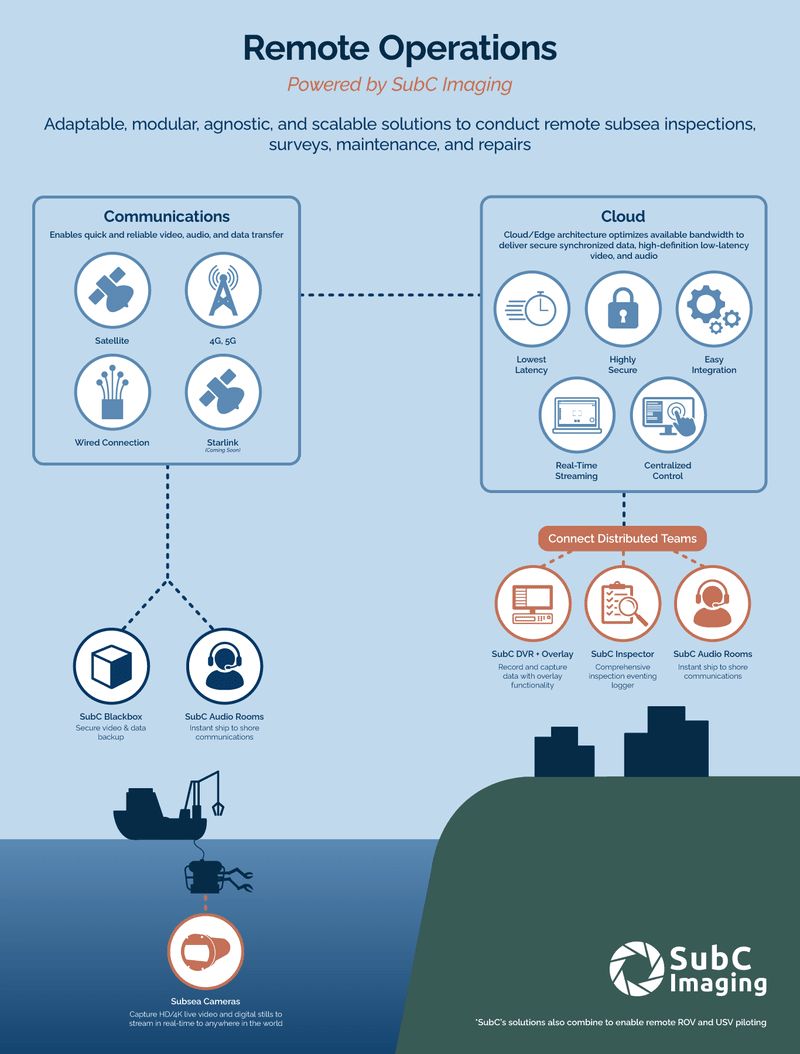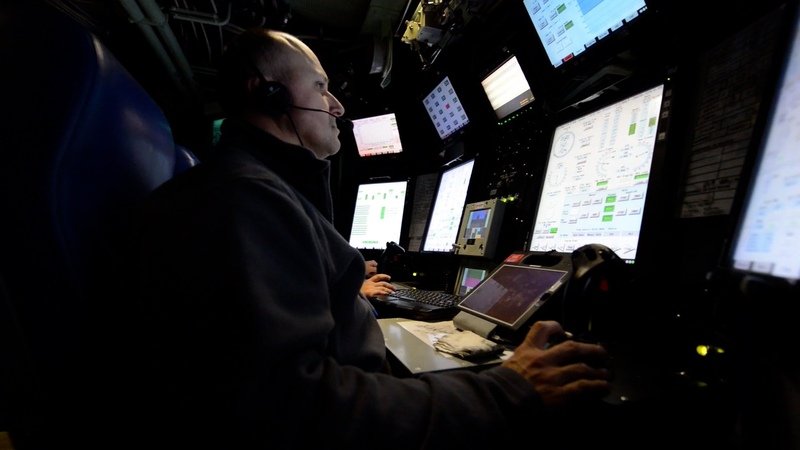The Role of Cloud Content Delivery Networks and Edge Architecture in Subsea Imaging Systems
Subsea imaging, with its unique challenges and technological requirements, has paved the way for innovative approaches to content delivery and data processing. As underwater exploration, marine research, and offshore energy push boundaries, ensuring efficient and reliable access to subsea imagery has become paramount. Two prominent solutions have emerged to support this reliability: cloud content delivery networks (CDNs) and edge architecture.
These approaches offer distinct advantages in optimizing content delivery, processing, and latency reduction, which is why they are key factors in SubC Imaging’s Remote Operations solutions. While they have similarities, they also have some critical differences in their application in subsea imaging systems. Understanding the characteristics and trade-offs of CDNs and edge architecture is crucial for choosing the most suitable approach for subsea imaging, audio, and data applications. In this article, we will compare CDNs and edge architecture, exploring their respective roles, benefits, and considerations.
What is a Cloud Content Delivery Network?
A cloud content delivery network (CDN) is a globally distributed network of servers that efficiently delivers web content, such as images, videos, and files, to end users. By distributing content through servers strategically positioned in various locations, CDNs reduce latency and improve the performance of content delivery. CDNs also offer scalability, load balancing, and security features, making them essential for applications seeking to enhance user experience and handle increased demand.
What Role Do Cloud Content Delivery Networks (CDNs) Play in Subsea Imaging?
CDNs can play a crucial role in efficiently delivering and distributing imagery captured underwater. Here are a few ways in which a CDN can contribute:
Improved Content Delivery Speed
Subsea imaging often involves capturing high-resolution images or videos in challenging underwater environments. Getting the video and data from offshore to onshore has the biggest impact on latency. Choosing a server in your geographic location will allow you to cut down on unnecessary hops to get the content to your PC.
Global Reach and Accessibility
CDNs have a network of servers distributed worldwide, which enables them to bring the subsea imaging content closer to the end-users regardless of their geographic location. This global presence ensures that users from different regions can access the imagery with minimal latency and network congestion.
Scalability and Load Balancing
Subsea imaging projects may generate large volumes of data, especially if multiple cameras or sensors are used simultaneously. CDNs provide scalability by handling increased traffic loads during peak usage periods. By distributing the load across multiple servers, a CDN can effectively manage the delivery of subsea imagery to numerous users or applications concurrently.
Redundancy and Reliability
Underwater imaging projects often require a high level of reliability, ensuring continuous availability of visual data. CDNs offer redundancy by storing multiple copies of the content across their server network. If one server becomes unavailable or experiences issues, the CDN can automatically route requests to other healthy servers, ensuring uninterrupted access to the subsea imagery.
Security and Protection
CDNs can provide additional security measures to protect subsea imagery. They can offer features like SSL/TLS encryption to secure data transmission, access controls, and DDoS mitigation to prevent malicious attacks that could disrupt content delivery.
To sum it up, CDN in subsea imaging helps optimize content delivery speed, ensure global accessibility, provide scalability, enhance reliability, and offer security measures. These capabilities contribute to the efficient and reliable distribution of subsea imagery to end-users or applications around the world.
What is Edge Architecture?
Edge architecture is a computing approach that brings computational power closer to where data is generated or needed, rather than relying solely on centralized cloud infrastructure. It involves deploying smaller-scale computers or devices, called edge devices, at the network's edge. These edge devices can process and analyze data right where it is generated, reducing delays and improving response times. By bringing computing capabilities closer to the source, edge architecture enables faster decision-making, more efficient data processing, and greater autonomy in various applications, such as subsea imaging in offshore energy.
What Role does Edge Architecture Play in Subsea Imaging?
Edge architecture plays a significant role in subsea imaging by enabling real-time processing, optimizing bandwidth usage, supporting remote and autonomous operations, and providing redundancy and resilience.
Real-Time Processing
Subsea imaging often requires immediate processing and analysis of data to extract insights and make time-sensitive decisions. By deploying edge computing resources near imaging devices, like subsea cameras, or underwater vehicles, real-time processing can be performed locally. This eliminates the need to transmit large volumes of data to a centralized cloud infrastructure for processing, reducing latency and enabling quick responses to changing conditions or anomalies.
Bandwidth Optimization
Transmitting high-resolution subsea imagery to a centralized cloud infrastructure can be bandwidth-intensive, especially in remote offshore locations with limited connectivity. Edge architecture enables preliminary processing and compression of the data at the edge devices before transmission. This reduces the amount of data that needs to be transferred, optimizing bandwidth usage and minimizing data transfer delays. It ensures efficient utilization of network resources and facilitates the timely delivery of critical information.
Autonomous Operations
Edge architecture empowers autonomous operations in subsea imaging. By running advanced algorithms and decision-making processes on edge devices, underwater vehicles, and ocean imaging systems can operate autonomously in real-time. This includes tasks such as object detection, navigation, and path planning. Local processing at the edge enables these systems to adapt to dynamic underwater environments, make on-the-spot decisions, and execute predefined tasks efficiently, without relying on continuous communication with a centralized cloud infrastructure.
Redundancy and Resilience
In subsea imaging, maintaining a reliable network connection to a centralized cloud infrastructure can be challenging due to the remote and harsh offshore environments. Edge architecture provides redundancy and resilience by enabling local storage and processing capabilities. Even if the connection to the cloud is temporarily lost, edge devices can continue to operate and process data locally. This ensures operational continuity, data availability, and reduces dependency on a stable network connection.
Overall, edge architecture enhances subsea imaging by enabling real-time processing, optimizing bandwidth usage, supporting autonomous operations, and providing redundancy and resilience. It brings computational capabilities closer to the data source, enabling efficient and effective imaging operations in remote offshore environments.
Cloud CDNs vs. Edge Architecture for Subsea Imaging
When it comes to subsea imaging, the difference between cloud content delivery networks (CDNs) and edge architecture becomes crucial. CDN technology allows for the efficient distribution of content to end-users by leveraging a network of geographically dispersed servers. With CDNs, the emphasis is on centralized cloud-based infrastructure, reducing the need for hardware setup and maintenance. In the context of subsea imaging, this means that users can access and view images seamlessly without having to worry about the intricacies of server management. The CDN approach simplifies the process by requiring users to install the necessary software, and they are ready to utilize the subsea imaging capabilities. On the other hand, edge architecture involves the deployment of servers closer to the end-users, typically on their premises or in nearby facilities. This approach requires clients to set up and maintain their servers, which can be resource-intensive. While edge architecture offers the advantage of lower latency and greater control over data processing, it demands more significant efforts and investments from clients to establish and manage the servers for subsea imaging applications.
The decision between Cloud CDNs and edge architecture relies on your specific requirements for the subsea imaging project. Cloud CDNs are great for delivering subsea imagery to people all over the world. They have servers spread out in different locations closer to the end user. This means faster access to the images or videos and better performance. CDNs are useful for projects involving underwater exploration, research, and sharing marine data because they can handle a lot of traffic and ensure reliable content delivery.
Cloud Content Delivery Networks for Remote Monitoring
Using cloud CDN is best for remote monitoring. In this scenario, it’s likely that multiple individuals, regardless of their location, need to monitor a specific object or location in real-time. By leveraging a cloud content delivery network, the video, audio, and data streams can be efficiently routed through the closest CDN hub to each viewer. This ensures low latency, faster access, and improved user experience by reducing the distance between the source of the content and the viewers, enabling seamless remote monitoring from anywhere in the world.
Edge architecture, on the other hand, focuses on processing and analyzing subsea imagery data as quickly as possible. It’s best for users looking to keep all video, audio, and data within their network. Instead of sending all the data to a central location, edge architecture brings the processing power closer to the underwater cameras or sensors. This reduces delays and allows for immediate analysis of the images or videos. Edge architecture is beneficial for subsea imaging applications that require real-time processing, low delays, and on-site decision-making, like underwater robotics, marine research, and environmental monitoring.
Edge Architecture for Remote Piloting
One example where edge architecture has an advantage over CDN for subsea operations is remote piloting. Implementing edge architecture for remote piloting is highly advantageous as it aims to minimize latency, a critical factor in piloting operations. To achieve this, running a dedicated edge server becomes a preferred approach. By deploying an edge server closer to the pilots, the video, audio, and data can be transmitted with minimal delays, ensuring real-time responsiveness and enabling pilots to make immediate and precise decisions. This localized processing and direct communication pathway significantly enhance the overall efficiency and effectiveness of remote piloting tasks.
CDN & Edge Architecture for Remote Underwater Inspections
Sometimes a combination of both approaches is used: CDNs for global delivery and edge architecture for on-site processing. This gives you the best of both worlds, ensuring efficient content delivery and localized analysis for your subsea imaging needs. When it comes to remote underwater inspections, combining both CDN and edge architecture. CDNs facilitate the efficient distribution of live video feeds and sensor data from the underwater inspection site to remote viewers located worldwide, ensuring low latency and reliable content delivery. Meanwhile, deploying edge architecture enables localized data processing and analysis at the underwater site, minimizing latency and facilitating real-time insights. This hybrid approach optimizes both content delivery and data analysis, empowering remote viewers to access the live feeds quickly while enabling immediate decision-making based on localized data processing capabilities.
In the end, the choice between CDNs and edge architecture depends on what you need for your subsea imaging project. If you want to share the images widely and make sure they load quickly for people around the world, CDNs are the way to go. If you need fast analysis of the images or videos right where they are captured, edge architecture is a better option.
Conclusion
The role of cloud content delivery networks and edge architecture in subsea imaging systems is crucial for optimizing content delivery, real-time processing, and latency reduction. CDNs excel in efficient content distribution globally, ensuring fast and reliable access to subsea imagery, audio, and data from various geographic locations. They offer scalability, load balancing, redundancy, and security features. On the other hand, edge architecture brings computational power closer to the data source, enabling real-time processing, bandwidth optimization, autonomous operations, and providing redundancy and resilience. The choice between CDNs and edge architecture depends on specific requirements. CDNs are ideal for efficient global content delivery, while edge architecture excels in low latency, real-time analysis, and localized processing. Combining both approaches can provide the best of both worlds, optimizing content delivery and data analysis for remote underwater inspections.




